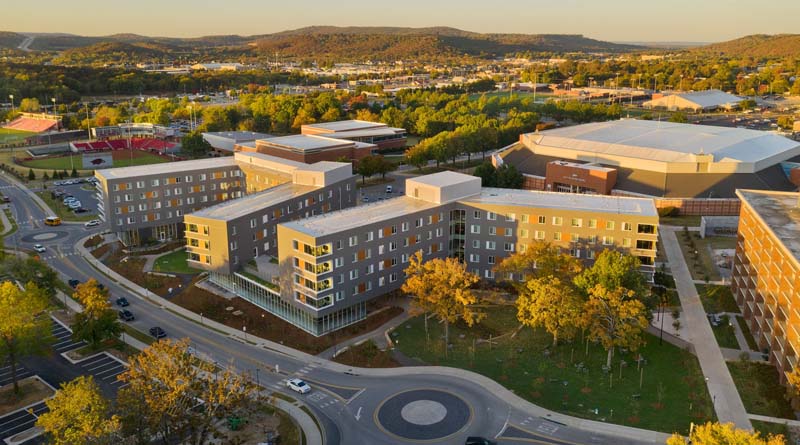Unique Living and Learning Hall Unveiled in Arkansas
FAYETTEVILLE, Ark.—A design collaborative led by Leers Weinzapfel Associates (Boston), Modus Studio (Fayetteville, AR), Mackey Mitchell Architects (St. Louis), and OLIN (Philadelphia), announces the completion of Adohi Hall, a $79M, 202,027-square-foot, 708-bed facility at the University of Arkansas. Now in use, the pioneering project is the nation’s first large-scale mass timber residence hall and living learning setting. A bold demonstration of sustainability, the five-story hall also signifies potential economic development for the burgeoning timber industry in Arkansas.
Occupying a linear, sloping, 4-acre site at the base of Fayetteville’s McIlroy Hill on the southern end of campus, the project provides a new university gateway that marks the start of a larger living learning district. Bound on the north by 1960s residence halls, on the east by Stadium Drive, and on the west and south by a large arena and related athletic facilities, the hall is nestled within a generous protective buffer of trees and plantings.
An emphasis on nature resonates throughout the project. Connected by a ground-level passage, a serpentine band of student rooms define three distinctive courtyard spaces that create a dynamic environment for student collaboration and interactive learning in architecture, design, and the arts. The “front porch” in the northernmost building is the key entry point for the complex; the “cabin” at the ground-level, central passage’s midpoint is the main gathering space, comprising a community kitchen, lounges, a quiet hearth, and a rooftop terrace; and the “workshops” of the lower courtyard house a dynamic live/learn program of performance spaces, music and recording studios, and maker spaces that enhance the campus-wide arts program.
Four-story residential floors are arranged above the communal spaces. The main stair and elevator for each open onto a series of double-height lounges and kitchen spaces, joining upper and lower floors and inviting community interaction. Each floor contains semi-suites for two students with private baths, and pods of six to eight double rooms with a shared bath and common room. Large study rooms with generous windows at the end of each wing create a series of “lanterns” along Stadium Drive.
The warmth of the project’s exposed structural wood ceilings is apparent in student rooms, study rooms, floor lounges, and ground floor common spaces, and wood columns bring the beauty of the material within reach for all. The “cabin” also includes a wood ceiling and trusses that span the full width of its lounge spaces. Exteriors feature a light metal jacket of zinc-toned panels with accents of textured copper-tone and white that creates a floating band of living space above the natural landscape below.
Integrated into the topography of its site, the new housing complex features a cascading series of outdoor spaces that provide students and visitors with a variety of opportunities to engage and gather. Sinuous pathways are intricately woven through existing stands of mature oak trees, providing much needed shade for the new residents to enjoy warmer months outdoors. Undulating landforms, local sandstone seating areas, and drifts of native planting recall the geological and ecological vernacular of the Ozark Plateau while simultaneously creating comfortable places for people. Stormwater infiltration is carefully integrated into the grading strategy, which captures runoff from both paved areas and buildings.
The name Adohi (“a-doe-hee”) is a Cherokee word meaning “woods.” It honors tribe members who passed near the hall’s site while following the Trail of Tears (1837-1839). It also recognizes the enduring importance of wood and sustainable forestry to the region.
Nabholz Construction Corporation of Rogers, Arkansas, served as Construction Manager for the project, providing installation of the mass timber package.

